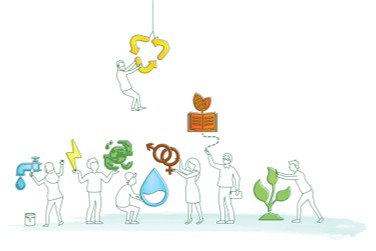Enterprise Profile
This type of enterprise offers services based on innovative and state-of-the art technology, typically contributing towards solving key challenges related to the sustainability and efficiency of water management systems and projects. Its B2B/B2G business model creates recurring revenue, which allows the company to grow and eventually reach profitability.
Business Model Features
This type of enterprise offers primarily services based on state-of-the art technological solutions, which aim to create water related impact on a larger scale – e.g., improving network management, facilitating more effective project implementation, ensuring more efficient use of water resources, or enhancing waste treatment. Its main customer groups are governmental agencies, utilities and businesses, which provide a revenue stream that is more stable and predictable. The services typically have to be personalized to the client’s needs due to the technological complexity of the services, meaning that customer relationship management is crucial for this enterprise.
Context and Environment
The enterprise is selling its services mainly in urban areas where they can reach more end-beneficiaries. Yet, rural areas are not excluded from taking use of the services and the enterprise could be operating in developing as well as developed economies. Similar to that of other B2B/B2G businesses, the operating context of the enterprise depends more on the needs and willingness to pay of its clients than the context as such.
Impact Potential
The businesses in this category offer tech-driven services to governmental organizations and businesses, aiming typically at improving water quality or conservation within their locality. Due to the B2B/B2G nature of the company, the impact on the end-consumers of the enterprise is mainly indirect. Yet, impact-driven enterprises with a convincing theory of change are sometimes able to demonstrate substantial impact, for instance, by enhancing efficiency and thereby enabling their clients to make services more affordable or accessible for disadvantaged communities or contributing to reducing resource consumption.
Potentially relevant SDG Targets
Water-related impact
SDG 6.1 By 2030, achieve universal and equitable access to safe and affordable drinking water for all.
SDG 6.2 By 2030, achieve access to adequate and equitable sanitation and hygiene for all and end open defecation, paying special attention to the needs of women and girls and those in vulnerable situations.
SDG 6.3 By 2030, improve water quality by reducing pollution, eliminating dumping and minimizing release of hazardous chemicals and materials, halving the proportion of untreated wastewater and substantially increasing recycling and safe reuse globally.
SDG 6.4 By 2030, substantially increase water-use efficiency across all sectors and ensure sustainable withdrawals and supply of freshwater to address water scarcity and substantially reduce the number of people suffering from water scarcity.
SDG 6.6 By 2020, protect and restore water-related ecosystems, including mountains, forests, wetlands, rivers, aquifers and lakes.
SDG 6.a By 2030, expand international cooperation and capacity-building support to developing countries in water- and sanitation-related activities and programmes, including water harvesting, desalination, water efficiency, wastewater treatment, recycling and reuse technologies.
SDG 6.b Support and strengthen the participation of local communities in improving water and sanitation management.
Team and Experience
The businesses in this typology vary in terms of their experience. Due to the high technical nature of the solutions, experience in technology as well as R&D is highly relevant in order to provide high-quality and tailored service.
Compared to the company’s strong technological expertise, marketing/sales and financial management skills are typically not one of its assets. Complementing the existing expertise with marketing/sales and finance experience will contribute to receiving financing and acquiring clients.
Financial Profile
The enterprise has typically a relatively high capital expenditure requirement due to the investment into the technology. This is covered by its high profitability due to servicing B2B and B2G clients, and its stable revenue growth, allowing the enterprise to reach its break-even point within a comparably short time frame. In case CapEx is high, the enterprise needs to be able to scale and grow fast.
Having a recurring revenue stream or a strong relationship to its clients will be critical to the enterprise for finding capital, especially debt. In order to receive debt financing, the enterprise also needs to demonstrate a solid financial track record and a concrete projection of revenue growth.
What are your Financing Options?
Grant and Results-based Finance (Impact bond, SIINC, performance-based loan, performance-based contract)
Due to the enterprise’s high innovative strength in using new technological solutions, R&D grant funding will be an option. While it is usually harder for B2B/B2G businesses to access impact-oriented grant funding or results-based financing, enterprises in this category are able to access result-based financing by proving, for instance, the increase in efficiency of their B2B/B2G clients. The impact-orientation comes from the fact that the clients are mainly providers of water-related public good that operate on scale.
Equity or alike (common stock, preferred equity, convertible note)
If the enterprise is able to demonstrate long-term financial viability with an adequate revenue growth and profitability that covers the higher upfront investment within a few years, it is likely to attract equity or equity-like investors. Depending on the technology, it can be challenging to agree on a valuation of the enterprise, in which case using convertible notes can be more convenient than traditional equity. Having professional finance experience is critical for this step.
Debt or alike (debt, subordinated loan, venture debt)
For this type of enterprise, debt funding might be an option, if it can demonstrate a recurring revenue stream or strong relationship to client, indicating a stable revenue projection. Some enterprises might be eligible for venture debt in order to fund working capital or capital expenses, but only if it has already been funded by a venture capital firm.

